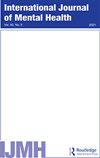2019冠状病毒病大流行期间约旦护士抑郁、焦虑和压力的患病率和预测因素
IF 1.4
Q3 PSYCHOLOGY, CLINICAL
引用次数: 12
摘要
摘要背景新冠肺炎是一种传染病,医护人员,尤其是护士需要长时间照顾患者,对他们的身心健康构成广泛威胁。目的调查约旦护士中抑郁、焦虑和压力的患病率和预测因素。方法本研究于2020年3月3日至3月24日对405名护士进行在线调查。使用阿拉伯语版的抑郁、焦虑和压力量表(DASS)。结果本研究结果显示,抑郁、焦虑和压力在护士中非常普遍(分别为57.8%、42.4%和50.1%)。与2019冠状病毒病(新冠肺炎)患者有过密切接触的人比他们的同行表现出更强的心理反应。抑郁、焦虑和压力的全回归模型(包括性别、儿童数量和与新冠肺炎患者打交道)具有统计学意义(F(3.216)=11.801;p < 0.001),(F(3216)=10.501;p < 0.001),和(F(3216)=11.659;p < 0.001)。结论在新冠肺炎大流行期间,约旦临床护理人员的抑郁、焦虑和压力水平较高。因此,应优先考虑护士的心理健康状况,特别强调那些与新冠肺炎感染患者接触的人、女护士和有孩子的人。本文章由计算机程序翻译,如有差异,请以英文原文为准。
Prevalence and predictors of depression, anxiety, and stress among Jordanian nurses during the coronavirus disease 2019 pandemic
Abstract Background COVID-19 is an infectious disease with a wide range of physical and psychological health threats among health care workers, in particular, nurses because they spend a long time caring for their patients. Aims To investigate the prevalence and predictors of depression, anxiety, and stress among Jordanian nurses. Methods This study was conducted among 405 nurses using an online survey from March 3, 2020 to March 24, 2020. The Arabic version of the Depression, Anxiety, and Stress Scale (DASS) was used. Results the findings of this study showed that depression, anxiety, and stress were highly prevalent among nurses (57.8, 42.4, and 50.1%, respectively). Those who had close contact with a coronavirus disease 2019 (COVID-19) patient showed stronger psychological reactions than their counterparts. The full regression models in terms of depression, anxiety, and stress which contained gender, number of children, and dealing with a person with COVID-19 were statistically significant (F (3, 216) = 11.801; p < 0.001), (F (3, 216) = 10.501; p < 0.001), and (F (3, 216) = 11.659; p < 0.001), respectively. Conclusion In the COVID-19 pandemic, the levels of depression, anxiety, and stress are high among Jordanian nursing working in clinical settings. Hence, the mental health status of nurses should be given a priority, with a specific emphasis on those who are in contact with infected patients with COVID-19, female nurses, and those who have children.
求助全文
通过发布文献求助,成功后即可免费获取论文全文。
去求助
来源期刊

INTERNATIONAL JOURNAL OF MENTAL HEALTH
PSYCHOLOGY, CLINICAL-
CiteScore
3.80
自引率
20.00%
发文量
32
期刊介绍:
The official journal of the World Association for Psychosocial Rehabilitation, the International Journal of Mental Health features in-depth articles on research, clinical practice, and the organization and delivery of mental health services around the world. Covering both developed and developing countries, it provides vital information on important new ideas and trends in community mental health, social psychiatry, psychiatric epidemiology, prevention, treatment, and psychosocial rehabilitation.
 求助内容:
求助内容: 应助结果提醒方式:
应助结果提醒方式:


